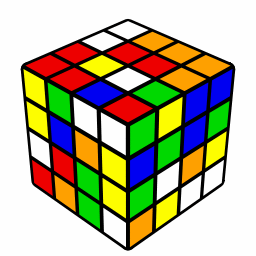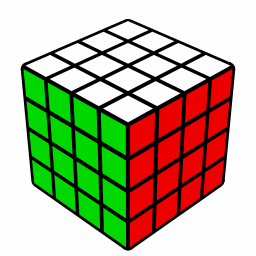4x4x4 Rubik's cube
 |
 |
The 4x4x4 Rubik's cube, also called the "Rubik's revenge", is a twisty combinatorial puzzle having four layers. If some NxNxN cube should be proud owner of a title "royal cube", a 4x4x4 would be one of the earnest candidates for it. It's because it is possible to solve any NxNxN Rubik's cube by applying the same principle to its solution.
On this page you will find:
- 4x4x4 Rubik's cube - grouping of center pieces together
- 4x4x4 Rubik's cube - pairing-up of wing edges
- 4x4x4 Rubik's cube - reduction to the 3x3x3 cube
- 4x4x4 Rubik's cube - solving of a so-called PLL and OLL parity
- world record videos
4x4x4 Rubik's cube - grouping of center pieces together
| The simulator starts by grouping of white center, consisting of 4 center pieces (moves 1-8). A color of opposite center is the one which cannot be found on corner pieces containing white color - i.e. a yellow one (moves 9-20). Then red center pieces are grouped together (moves 21-25), followed by blue center pieces (moves 26-34). From corner pieces on a real cube, one can notice that orange center must be opposite to the red one, as well as blue center has to be opposite to the green one (assuming a conventional puzzle color scheme). Therefore, last two centers (green and orange one) must conform to it (moves 35-43). In a final part (moves 45-47), red and orange center are being swapped, so that the colors of centers would match the colors of corners (those are not shown on the simulator). |
4x4x4 Rubik's cube - pairing-up of wing edges
We will pair-up wing edges (see terminology on Fig. 1 at a number of combinations for the NxNxN Rubik's cube page) by means of commutators.
| For this purpose, the simulator uses mainly r' U' R2 U r (moves 5-9, for example) or r U' R2 U r' (by commutator definition, a sequence should end with an R2' move, however, in this case it is not necessary to execute such a move - then a conjugation is more precise term for it rather than commutator), where r and r' have the same meaning as R and R' (see notation), nevertheless, inner layers instead of outer ones are being rotated. From the structure of algorithms it comes that the first move pairs-up wing edges, by second, third and fourth move we will exchange already paired-up wing edge pair for non-paired-up wing edge pair and group center pieces together again in the last move. |
Sadly, just described procedure for pairing-up of wing edges can't be applied to only two pairs (4 cubies in total) of these non-paired-up pieces. The reason is there wouldn't be a third pair of wing edges on the cube through which the scrambled center pieces would be subsequently grouped together. So what to do if there are only two pairs of non-paired-up wing edges on a cube? It's simply sufficient to make three out of two pairs by inverse process to a pairing described in the previous paragraph. It means the first move won't pair-up wing edges and to group center pieces together, we will use paired-up pair of wing edges (which will become non-paired-up one). This will lead to three instead of two pairs of non-paired-up wing edges (and we already know how to solve it). Alternatively, we can avoid a situation in which there would be only two non-paired-up pairs of wing edges on a cube during a pairing-up procedure - see the simulator above, namely the setup moves 66-72 and subsequent pairing-up of last three pairs of wing edges simultaneously (moves 73-77).
4x4x4 Rubik's cube - reduction to the 3x3x3 cube
Now a solution tutorial on the 3x3x3 Rubik's cube can be used.
 |
However, there are two situations which can not occur on a 3x3x3 cube. So-called PLL and OLL parity, to be specific.
4x4x4 Rubik's cube - solution to so-called PLL and OLL parity
Since everything important (how to avoid a so-called PLL parity as well as a so-called OLL parity in 100% of cases at the end of a solve, what's the cause of their appearance, or why there aren't considered more positions/configurations as a so-called PLL parity) can be found in an article about the parity problem (which also includes Cage method), we will limit ourselves to just a solution to these two situations.
On the picture below we see a diagram of a so-called PLL parity for the upper layer of a 4x4x4 cube. The arrows indicate what wing edges are to be swapped.
 |
| By the first move, we will take out a yellow-green and yellow-blue wing edge. In the second move, we will rotate the upper layer so that both mentioned wing edges could by inserted (see a move no. 3) to the places where they actually belong. By doing so, however, the other yellow-green and yellow-blue wing edge got moved to the lower layer. Therefore, by the fourth move, we will rotate the upper layer again so that these wing edges could be inserted into their right places - see fifth move. By sixth move we group the center pieces together again. As a move no. 7, it can be used either u2 (see a simulator) or d2 - only a symmetrical distribution of pieces on a cube is important here. Through eight move we swap (among others) two green center pieces, which leads to a solution of all layers. Thus, in the final move no. 9, we will get a solved cube. |
Next simulator solves the same starting configuration in one step, which means a solution of wing edges and grouping of center pieces together is combined.
If you want to swap two adjacent composite edges (at the UF and UR positions) instead of opposite ones (UF and UB), use conjugations - first rotate the cube as a whole so that the swapped composite edges would be at the UF and UR positions (when viewed as a 3x3x3 cube). Then execute R2 D B2 moves and originally adjacent composite edges will become opposite ones. We can already solve such a case. After the application of moves from the simulator, execute inverse moves, i.e. B2' D' R2' in order to get upper-back edge back to the UR position (when viewed as a 3x3x3 cube). Instead of 3 initial moves, you can use only 2 of them - namely R B. However, after the application of moves from the simulator and execution of inverse moves B' R', composite edges at the UF and UR positions will be oriented incorrectly.
| Aside from nothing-saying algorithm like r2 B2 U2 l U2 r' U2 r U2 F2 r F2 l' B2 r2, we can also solve a so-called OLL parity intuitively. We will scramble and group center pieces together again in a way so that the number of moves of inner layers would be equal to an odd number. Although non-paired-up pairs of wing edges will be made (after a move no. 9), by pairing them up and subsequent puzzle reduction to a 3x3x3 cube we won't encounter a so-called OLL parity anymore. Naturally, you don't need to pair-up wing edges in the same order as shown on the simulator - nevertheless, if you find this sequence interesting, see its explanation on the first video in already linked article about a parity problem. |
World record videos
As a football has FIFA and athletics has IAAF, also the 4x4x4 Rubik's cube has some sort of board that organizes the competitions worldwide. It is WCA - World Cube Association. Thus it can be officially competed in a solving of the 4x4x4 Rubik's cube. It is competed in two formats: single fastest solve of the puzzle and average solve. As an average, five consecutive times of one round are taken, the best and the worst time is not considered and from the remaining three times an arithmetic mean is calculated.
| event: 4x4x4 single solve | ||
| name: Sebastian Weyer (Germany) | ||
| result: 17.42 s | ||
| scramble: available upon request | ||
| solution: available upon request | ||
| cube brand: MoYu WeiLong GTS2 M | ||
| solving methods: Yau, CFO(P), OLLCP | ||
| personal opinion on used methods: see below | ||
| competition: Danish Open; 13-15. 9. 2019; Denmark |
| event: 4x4x4 average solve | ||
| name: Max Park (USA) | ||
| result: 21.11 s | ||
| scrambles: available upon request | ||
| solutions: available upon request | ||
| cube brand: MoYu AoSu WR M | ||
| solving method: Yau | ||
| personal opinion on used method: see below | ||
| competition: Bay Area Speedcubin' 21; 1. 12. 2019; USA |
A 4x4x4 Rubik's cube is being solved while blindfolded as well. You can see world record videos in the blindfolded solving section.
If you find a so-called speedcubing interesting, check out an article about where to buy a Rubik's cube, what cube is the best and how to solve it faster.
Personal opinion on methods used in the world records
4x4x4 Rubik's cube:
What comes to my mind at first is that the solving methods for a 4x4x4 cube can be divided into three most commonly used groups: reduction to a 3x3x3 cube with subsequent 3x3x3 solving or solving of corners and composite edges followed by centers. The third group is represented by completely different way of solving.
Although the second case is being used by a minority of cubers, Sandwich as well as Cage method certainly deserves your attention. By a different method is mainly meant K4, and also Stadler method which is essentially Roux for a 4x4x4 cube. While Roux may be very fast for a 3x3x3 cube, execution of M moves in the inner layers of a 4x4x4 cube is generally more difficult. Sandwich, Cage and K4 can be, in my opinion, at least comparably fast to reduction followed by a 3x3x3 cube method.
As for reduction (see e.g. this tutorial on how to solve a 4x4x4 Rubik's cube), it primarily depends on how it is done - how wing edges are being paired-up. One pair, two, three, four or even six pairs of wing edges can be paired-up at once. Most of the fastest cubers pair-up the wing edges according to the following scheme: 3-2-2-2-3. Once pairing-up of wing edges is done, 3x3x3 cube method is being used (usually CFOP). Its innovation during a pairing-up process of wing edges (as well as grouping of center pieces together) is Yau (Hoya, respectively) method, where the first step of CFOP - a cross - is already done after the wing edges are paired-up. At the moment (end of 2012), all 5 world fastest speedcubers (in terms of average solve) use Yau method to solve a 4x4x4 Rubik's cube.
The page was graphically improved by Michael Feather and Conrad Rider.